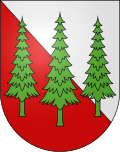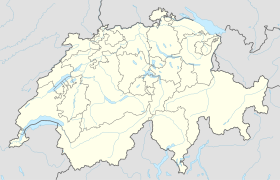Epesses
| Epesses | ||
|---|---|---|
| State : |
|
|
| Canton : |
|
|
| District : | Lavaux-Oron | |
| Municipality : | Bourg-en-Lavaux | |
| Postal code : | 1098 | |
| former BFS no. : | 5603 | |
| UN / LOCODE : | CH EPS | |
| Coordinates : | 547000 / 149101 | |
| Height : | 464 m above sea level M. | |
| Area : | 1.60 km² | |
| Residents: | 332 (December 31, 2010) | |
| Population density : | 208 inhabitants per km² | |
| Website: | www.epesses.ch | |
| map | ||
|
|
||
Until July 1, 2011, Epesses was a municipality in the Lavaux-Oron district in the canton of Vaud in Switzerland . It merged with Cully , Grandvaux , Riex and Villette (Lavaux) to form the new political municipality of Bourg-en-Lavaux .
geography
Epesses lies at 464 m above sea level. M. , ten kilometers east-southeast of the canton capital of Lausanne (as the crow flies). The village extends over a small area of tilled land in the middle of the vineyards on the steep slope of Lavaux , on the slope of Mont de Gourze in a panoramic position around 80 m above lake level of Lake Geneva .
The area of the 1.6 km² municipal area includes a section of the Lavaux on the north-eastern shore of Lake Geneva (around 700 m of the lakeshore line). The parish extends from the lake shore northwards up the steep slope of Epesses to the forest heights east of Mont de Gourze. The slope is drained by the village stream Rio d'Enfer to Lake Geneva. At the height above the farm Bois de Romont is 864 m above sea level. M. reached the highest point of Epesses. In 1997, 10% of the municipal area was in settlements, 29% in forests and woodland, 60% in agriculture and a little more than 1% was unproductive land.
Epesses consists of the actual village center, the two hamlets Crêt-Dessus ( 459 m above sea level ) and Crêt-Dessous ( 432 m above sea level ), each located on the Rio d'Enfer, and a few free-standing farms. Neighboring parishes of Epesses were Cully , Riex , Forel (Lavaux) and Puidoux .
population
With 332 inhabitants (as of December 31, 2010) Epesses was one of the small communities in the canton of Vaud. 88.6% of the residents are French-speaking, 3.3% German-speaking and 3.3% Portuguese-speaking (as of 2000). The population of Epesses was 382 in 1850 and 419 in 1900. The population remained more or less constant until 1960 (381 inhabitants), and since then the population has decreased by around 20%. This decline is due to the fact that no new buildings are allowed to be built in the vineyards.
economy
Most of the houses in the village center are inhabited by winegrowers who tend the 52 hectares of vineyards in the municipality. Apart from a few restaurants, there have been no more shops since the end of 2002. The cultivation of quality wines is now the main line of business. Are produced v. a. dry white wines , mainly from the Chasselas grape variety , but also red wines ( Pinot Noir , Syrah, etc.) and specialties. There are three well-known locations in Epesses:
- Epesses (north and west of the village center, partly in the municipality of Riex )
and especially the grands crus (large plants)
- Calamin (south of the village center, down to Lake Geneva)
- Le Dézaley (in the east; partly already in the municipalities of Puidoux and Rivaz )
traffic
Epesses is away from the thoroughfares, but is still well developed in terms of traffic. A connecting road from Cully to Chexbres leads through Epesses, along the lakeshore is main road 9 . The next motorway connection to the A9 (Lausanne-Sion), which opened in 1974 and crosses the former municipality, is Chexbres, around 3 km from the village.
On April 2, 1861, the Lausanne-Villeneuve section of the railway line from Lausanne to Valais with the Epesses station (on the lakeshore) went into operation. A bus line takes care of the fine distribution in public transport, which operates the route from Cully via Epesses and Chexbres to Puidoux-Chexbres train station.
history
Traces of a Roman road and coin finds point to an early settlement of the municipality. The first written mention of the place took place in 1166 under the name Espesses ; In 1228 the name Spesses appeared . The place name is derived from the Latin word spissa (dense, thick), which probably means the red fir.
In the Middle Ages, Epesses was under the Benedictine abbey of Lutry . With the conquest of Vaud by Bern in 1536, the village came under the administration of the Bailiwick of Lausanne . After the collapse of the Ancien Régime , Epesses belonged to the canton of Léman from 1798 to 1803 during the Helvetic Republic , which then became part of the canton of Vaud when the mediation constitution came into force . In 1798 it was assigned to the Lavaux district.
It was not until 1824, when the large municipality of Villette was divided, that Epesses achieved the status of an independent political municipality. A project to merge the five now independent municipalities of Cully, Epesses, Riex, Grandvaux and Villette (Lavaux) failed in a vote on February 27, 2005 due to resistance from the people of Grandvaux. The project was therefore not pursued any further for the time being. The merger of these five municipalities to form the new municipality of Bourg-en-Lavaux only came into effect on July 1, 2011.
Attractions
Epesses, with its densely packed, often juxtaposed houses, mostly from the 17th to 19th centuries, offers a picturesque townscape. The core of the Saint-Jacques chapel dates back to the 14th to 16th centuries and has since been restored several times. The 15th century Haus Bovard is a listed building.
Web links
- Epesses Official Website (French)
- Germain Hausmann: Epesses. In: Historical Lexicon of Switzerland .
- Aerial views of the village and its surroundings
- Website of the Epesses winemakers




